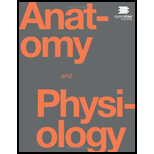
Concept explainers
Watch this video (http://openstaxcollege.org/l/capillaryfunct) to explore capillaries and how they function in the body. Capillaries are never more than 100 micrometers away. What is the main component of interstitial fluid?
To review:
The main component of interstitial fluid.
Introduction:
Interstitial fluid also called the extracellular fluid surrounds all body tissues. It mainly contains water as solvent with suspended particles, solutes and white blood cells in it.
Explanation of Solution
All tissues of our body seem to be bathing in a liquid called the extracellular fluid or the interstitial fluid. This fluid is more like the lymph flowing through the lacteals. The interstitial fluid has water as solvent which is the makes up the most of its content.
This aqueous solution contains sugars, amino acids, electrolytes along with dissolved oxygen and other gases. There are white blood cells freely floating in it. It differs from plasma in the protein composition as the plasma is rich in protein.
The exact composition if interstitial fluid however depends on the location of the body considered. This fluid contains substances like hormones, neurotransmitters or proteins according to the area where they are produced and transported.
Even metabolic wastes products like carbon dioxide, nitric oxide, urea or ammonia are found in it. Just that its dynamic composition is dependent on the tissue it is found associated with. This is so because the interstitial fluid functions to allow exchange of nutrients and wastes between blood in capillaries and tissues.
The interstitial fluid is mainly composed of aqueous solvent with dissolved electrolytes, gases and suspended white blood cells. It functions to provide medium of exchange of substances between blood and the tissue it surrounds.
Want to see more full solutions like this?
Chapter 20 Solutions
Anatomy & Physiology
Additional Science Textbook Solutions
College Physics
Human Anatomy & Physiology (2nd Edition)
Human Biology: Concepts and Current Issues
Campbell Biology: Concepts & Connections (8th Edition)
Concepts of Genetics (12th Edition)
Microbiology: An Introduction
- Match the type of blood vessel with its major function. _____ arteriesa. diffusion _____ arteriolesb. control of blood distribution _____ capillariesc. transport, blood volume reservoirs _____ veinsd. blood transport and pressure regulatorsarrow_forwardThe process of recording a picture of blood vessels is called ____________________.arrow_forwardSeveral years ago the deaths of several airline travelers led to warnings about economy-class syndrome. The idea is that economy-class passengers dont have as much leg room as passengers in more expensive seats, so they are more likely to sit essentially motionless for long periods on flightsconditions that may allow blood to pool and clots to form in the legs. This condition is called deep-vein thrombosis, or DVT. Given what you know about blood flow in the veins, explain why periodically getting up and moving around in the planes cabin during a long flight may lower the risk that a clot will form.arrow_forward
 Anatomy & PhysiologyBiologyISBN:9781938168130Author:Kelly A. Young, James A. Wise, Peter DeSaix, Dean H. Kruse, Brandon Poe, Eddie Johnson, Jody E. Johnson, Oksana Korol, J. Gordon Betts, Mark WomblePublisher:OpenStax College
Anatomy & PhysiologyBiologyISBN:9781938168130Author:Kelly A. Young, James A. Wise, Peter DeSaix, Dean H. Kruse, Brandon Poe, Eddie Johnson, Jody E. Johnson, Oksana Korol, J. Gordon Betts, Mark WomblePublisher:OpenStax College Human Biology (MindTap Course List)BiologyISBN:9781305112100Author:Cecie Starr, Beverly McMillanPublisher:Cengage Learning
Human Biology (MindTap Course List)BiologyISBN:9781305112100Author:Cecie Starr, Beverly McMillanPublisher:Cengage Learning Human Physiology: From Cells to Systems (MindTap ...BiologyISBN:9781285866932Author:Lauralee SherwoodPublisher:Cengage Learning
Human Physiology: From Cells to Systems (MindTap ...BiologyISBN:9781285866932Author:Lauralee SherwoodPublisher:Cengage Learning





